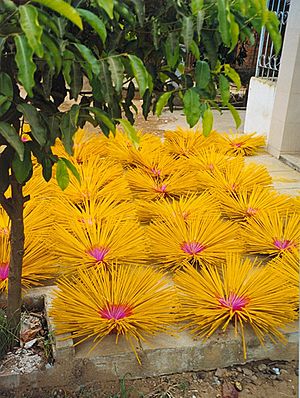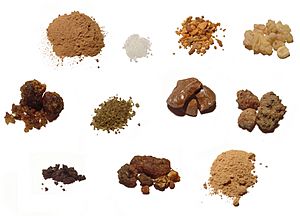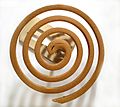Incense facts for kids
Incense is a special material that creates a nice smell when it burns. People use it for many reasons, like making a room smell good, helping with meditation, or during religious ceremonies. It can also be used to cover up bad smells or keep insects away.
Incense is made from plants that smell good, often mixed with oils. There are two main types:
- Indirect-burning incense: This type needs a separate heat source, like a hot coal, to make it smoke and smell. It can't burn by itself.
- Direct-burning incense: This type can be lit directly with a flame. You light it, then blow out the flame, leaving a glowing part that slowly burns and releases its scent. This kind often comes as a stick (sometimes with a bamboo core) or a cone.
Incense has been important in many cultures for a very long time. In Judaism, instructions for using incense are found in the ancient text of Exodus. In Christianity, the wise men brought myrrh and frankincense as gifts to Christ. The word "incense" comes from the Latin word incendere, which means "to burn."
People in Hinduism also use incense in their rituals. Long ago, the Babylonians used incense when they prayed. From there, the use of incense spread to ancient Greece and Rome.
What Incense is Made Of
Many different things can be used to make incense. Historically, people often used materials found in their local area. For example, Native Americans used plants like sage and cedar. Trading incense materials was a big part of business along famous routes like the Silk Road and the Incense Route.
The way incense was made depended a lot on local knowledge and tools. But it was also influenced by people traveling from other places, including religious leaders and doctors who knew about incense making.
How Incense is Made

To make incense, the raw materials are first ground into a powder. Then, they are mixed with a special binder to form a paste. For direct-burning incense, this paste is then shaped and dried. Often, flower scents are popular, but citrus smells like lemon are also common.
The incense mixture is often rolled into a flat sheet, about 1 cm thick. It is left to firm up, then cut into small cubes. These cubes are coated with clay powder to stop them from sticking together. Finally, they are left to fully harden and dry. In Greece, this type of rolled incense comes in pink (for rose scent) or green (for jasmine scent).
Incense mixtures can also be pressed into different shapes. A small amount of water is added to the fragrance and incense base. This mixture is kneaded into a stiff dough. The dough is then pressed into molds to create cone shapes or smaller coiled incense. It can also be pushed through a hydraulic press to make solid stick incense. After shaping, the incense is trimmed and slowly dried.
Images for kids
-
A Räucherkerzchen – a charcoal-based incense cone.
-
Joss sticks burning in the Temple of Literature, Hanoi in Vietnam.
-
The giant Botafumeiro thurible swinging in the Cathedral of Santiago de Compostela.
-
Mosquito repellent often comes in a coil shape and burns like incense.
See also
 In Spanish: Incienso para niños
In Spanish: Incienso para niños



















